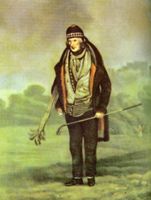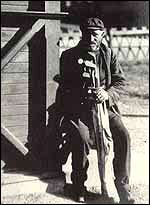

|
|||||
The Evolution Of Golfers And Caddies
|
 Caddie Willie 1838 |
Gentleman golfers of the 18th
century often had many personal servants. It was only natural
that an elite gentleman would have a servant tote his clubs
and find his balls for him. A caddie. Many matches would also make use of a "forecaddie". The forecaddie was so-called because of their job as a "forward caddie", one who would be sent up ahead to sight the driven ball. The grazing of the sheep and rabbits was all that would cut the grass, so players tended to rely on the forecaddie at every hole. The players, to alert the forecaddies to spot the flight of the ball, yelled "Fore". |
| The old time caddies were men from hard backgrounds whose nicknames occasionally suggested just how they had to be to survive. With feathery balls costing a week's wage and with the popularity of gambling among players, a crooked forecaddie who might also accept bribes from players, could supplement his wages handsomely. Willie Johnson, for instance, became known as "Trap Door," because he pretended one leg was shorter than the other was and had a special boot made with a hollow sole. In it, he hid "lost" golf balls, which he later sold back to his clients. His boot, it is claimed, could hold half a dozen golf balls. |  Willie "Trap Door" Johnson |
Eventually forecaddies were phased out, at least in everyday play, but the army of volunteers spotting balls at any professional event holds testimony to their continued use. I suppose that the luxury of a forecaddie is something that most of us will never experience. Unless one had the occasion to hit into the group ahead with a spectacularly long shot!
Over the centuries the duties of the tour professional's caddie have evolved into that of the player's right hand. No longer a lowly servant, but rather an important part of the team, caddies can help a golfer in many ways. They're part of the fabric of the game. They help to set the overall game plan and the plan of attack to each hole. They are responsible for knowing the correct yardage for every lie on every hole and must know the greens and pin placements to help manage the golfer's game. A good caddie also gives psychological support, steadying the player whenever necessary.
The pros have long-standing relationships with their caddies. Some players even seem to have difficulty performing without their regular "man on the bag".
The only tour caddie most of us could easily identify is Mike "Fluff" Cowan, the aging hippie who carries Tiger Woods' bag. His six-figure income is something none of his predecessors dared dream about.
Public golfers used to use caddies -- once. Over the years many junior golfers have earned their way onto fine courses by toting bags for members. Ben Hogan, Byron Nelson and Sam Snead, three of the finest golfers America has produced, all learned to play the game in caddie yards, with whatever balls and clubs they could find. The declining use of the caddie has hurt junior golf tremendously.
For the most part, at least in North America, caddies employed for public play are now rare indeed. But one can still have the pleasure of a caddie's company at some more traditional private golf strongholds. Hamilton Golf and Country Club still sports an active caddie pool, boasting 141 young caddies, one of the largest caddie programs in North America.
In Europe, golf cart usage is not as widespread, and at most courses in Scotland to this day, players get around a course in three hours with a caddie. And they don't rely on powered carts or lasers to do it. They rely on a good caddie.
Since the mid-1950s the spread of the motorized golf cart has been popular with golfers and a financial boon for the courses. Golf courses are, after all, businesses and carts are a source of revenue. Carts are mandatory at many courses all over the U.S., and although that practice is not as common at courses in and around Ottawa, it is only a matter of time before that trend comes closer to home.
The power cart has taken over, and has put the caddies out of work. Carts have quickly become the caddie's worst enemy. Caddies, and walking, aren't in the equation. By the mid-1970s the conversion was virtually complete. Even the cost of a cart rental is less expensive than hiring a caddie. Of course, the cart doesn't offer you what an experienced caddie can. However, Global Positioning Satellites are now being used to judge yardage’s on the golf course from your cart. I expect it is only a matter of time until wind speed, wind direction, and elevation changes could be monitored and factored into a cart's computer report. Who knows, perhaps even ground conditions could be assessed by the superintendent and included into the programming each day.
To the golf clubs’ collective defense though, golfers don't like the idea of paying someone a fair wage to carry their bags, and most would only have a caddie as a once in a lifetime extravagance. It is difficult for clubs to train caddies, only to have them stand around until someone wants to hire one for a round. Most clubs that have held on to their bag toters now classify them as independent contractors rather than employees. Unfortunately for the club, that does not generate revenue for anyone but the caddie.
As a way to preserve the tradition of caddies, some clubs have runners. Runners perform the same tasks as caddies, except they don’t carry bags. A runner will go with a twosome or a foursome, who all ride in a cart. The runner will locate balls, replace divots, tend to greens, and estimate distances, while golfers can concentrate on other things.
The mechanizing of caddie's services may be seen as progressive, but it's not a development we should necessarily cheer. However, there is an upside of the decline in caddie usage. It's a safe bet that no superintendent at a course with golf carts ever got a letter like the one written by a G. Leslie Smith in 1892. It complained about a caddie that apparently had a few too many "wee nips". "He could not tee the ball properly," the letter concluded, "and fell down."
Evolution – Change - Progress
Golf has seen it all. It will see more. It is certainly one of the oldest games still played in the world, and it is unique among sports.
The powers that be will resist change as much as possible, to preserve the traditions of the game and to ensure that it is never transformed into something unrecognizable. But in the end, change is inevitable. I don't pretend to know if that is good or bad, it just is. I do know one thing though, I am glad I don't have to play feathery balls with hickory shafted clubs on uncut fairways and on virtually unputtable greens. But I truly wonder what the old masters would think of today's game.

